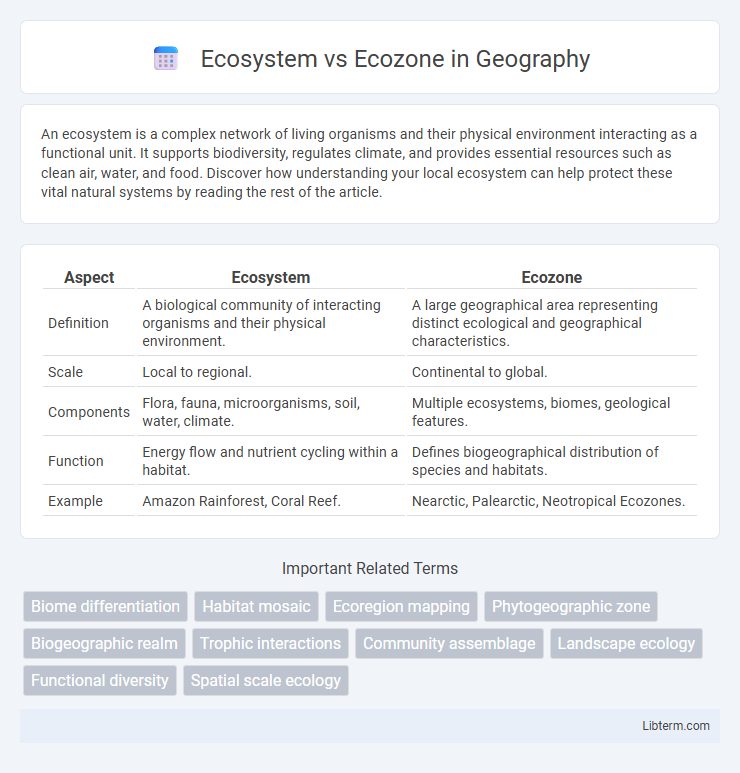An ecosystem is a complex network of living organisms and their physical environment interacting as a functional unit. It supports biodiversity, regulates climate, and provides essential resources such as clean air, water, and food. Discover how understanding your local ecosystem can help protect these vital natural systems by reading the rest of the article.
Table of Comparison
| Aspect | Ecosystem | Ecozone |
|---|---|---|
| Definition | A biological community of interacting organisms and their physical environment. | A large geographical area representing distinct ecological and geographical characteristics. |
| Scale | Local to regional. | Continental to global. |
| Components | Flora, fauna, microorganisms, soil, water, climate. | Multiple ecosystems, biomes, geological features. |
| Function | Energy flow and nutrient cycling within a habitat. | Defines biogeographical distribution of species and habitats. |
| Example | Amazon Rainforest, Coral Reef. | Nearctic, Palearctic, Neotropical Ecozones. |
Introduction to Ecosystems and Ecozones
Ecosystems are dynamic communities of living organisms interacting with their physical environment, encompassing biotic and abiotic components within a specific area. Ecozones, also known as biogeographic realms, represent large-scale geographic regions characterized by distinct assemblages of species and ecological patterns shaped by historical and evolutionary processes. Understanding ecosystems highlights localized interactions, while ecozones provide a broader context of biodiversity and ecological distribution across continents and climate zones.
Defining Ecosystem: Key Features
An ecosystem consists of diverse living organisms interacting with each other and their physical environment, forming a complex and dynamic network of energy flow and nutrient cycling. Key features include biotic components like plants, animals, and microorganisms, alongside abiotic factors such as water, soil, and climate, which together sustain ecological balance. Unlike ecozones, which are broader biogeographic regions based on climate and geography, ecosystems operate at specific local scales with focused species interactions and environmental conditions.
Understanding Ecozones: An Overview
Ecozones represent the broadest biogeographic divisions of the Earth, defined by distinct evolutionary histories and unique assemblages of flora and fauna, unlike ecosystems which are smaller units characterized by interactions among organisms and their physical environment. Understanding ecozones involves recognizing their role in biodiversity conservation, climate regulation, and biogeographical research, as they encompass multiple ecosystems within a similar ecological and evolutionary context. Key ecozones include the Nearctic, Palearctic, Neotropical, Afrotropical, Indomalayan, Australasian, and Antarctic, each hosting specialized species adapted to long-term environmental conditions.
Core Differences Between Ecosystem and Ecozone
An ecosystem is a functional unit consisting of living organisms interacting with their physical environment within a specific area, emphasizing energy flow and nutrient cycles. An ecozone, also known as a biogeographic realm, is a broader classification representing large geographic regions defined by distinct evolutionary histories and characteristic flora and fauna. Core differences include scale, as ecosystems are smaller and focused on interactions, while ecozones encompass extensive areas reflecting biological diversity shaped by continental history.
Components of an Ecosystem
An ecosystem comprises biotic components like plants, animals, and microorganisms interacting with abiotic factors such as soil, water, and climate to sustain ecological functions. These components form complex food webs and nutrient cycles that maintain energy flow and ecosystem stability. In contrast, an ecozone is a large geographic area characterized by distinct biological communities and climatic features but does not focus on the detailed interactions between organisms and their immediate environment.
Classification and Examples of Ecozones
Ecozones represent large-scale biogeographic regions characterized by distinct evolutionary histories and ecosystems, classified based on continental and climatic boundaries such as the Nearctic, Palearctic, Neotropical, Afrotropical, Indomalayan, Australasian, Oceanian, and Antarctic ecozones. These ecozones encompass multiple ecosystems, which are smaller units featuring specific biotic communities and abiotic factors interacting in a localized environment. For example, the Nearctic ecozone includes temperate forests, grasslands, and tundra ecosystems, while the Afrotropical ecozone covers savannas, tropical rainforests, and deserts, each supporting unique flora and fauna adapted to regional conditions.
Interconnections: How Ecosystems Fit Within Ecozones
Ecosystems are the dynamic communities of organisms interacting with their physical environment within a specific area, while ecozones represent large biogeographical regions characterized by distinct climate and species assemblages. Ecosystems function as nested units within ecozones, creating interconnected networks that support biodiversity and ecological processes across broader geographical scales. Understanding these interconnections helps in managing conservation efforts by recognizing how local ecosystem functions contribute to the stability and resilience of entire ecozones.
Ecological Importance of Ecosystems and Ecozones
Ecosystems and ecozones are fundamental ecological units that differ in scale but share critical ecological importance. Ecosystems, comprising interacting communities of organisms and their physical environment, maintain biodiversity, nutrient cycling, and energy flow essential for life sustainability. Ecozones represent larger biogeographic regions encompassing multiple ecosystems, supporting broad patterns of species distribution and evolutionary processes critical for ecological resilience and global biodiversity conservation.
Human Impact on Ecosystems vs. Ecozones
Human activities significantly alter ecosystems by directly affecting species composition, nutrient cycles, and habitat structure through deforestation, pollution, and urbanization. Ecozones, which are broader biogeographic regions characterized by distinct climatic and evolutionary histories, experience slower changes but are impacted by the cumulative effects of ecosystem disruptions and climate change. Understanding the human impact on ecosystems helps manage biodiversity loss locally, while recognizing changes in ecozones aids in global conservation strategies and climate resilience planning.
Conclusion: Embracing Holistic Environmental Perspectives
Understanding the distinctions between ecosystems and ecozones enhances environmental conservation strategies by addressing both localized interactions and broader biogeographical patterns. Ecosystems emphasize specific community dynamics and resource flows, while ecozones provide a macro-scale framework that encompasses multiple ecosystems with shared climatic and evolutionary histories. Embracing these holistic perspectives enables more effective biodiversity management and sustainable resource use across varied spatial scales.
Ecosystem Infographic

 libterm.com
libterm.com